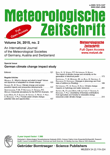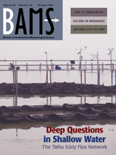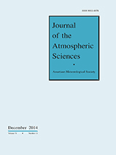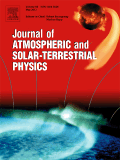
ADVANCES IN ATMOSPHERIC SCIENCES
Scope & Guideline
Shaping the Future of Climate Science
Introduction
Aims and Scopes
- Climate Variability and Change:
Research exploring the effects of climate change on atmospheric conditions, including temperature extremes, precipitation patterns, and seasonal forecasts, particularly in relation to specific regions like East Asia. - Atmospheric Dynamics and Weather Systems:
Studies examining the dynamics of weather systems such as tropical cyclones, monsoons, and their interactions with larger climate patterns, focusing on their predictability and impacts. - Remote Sensing and Data Assimilation:
Utilization of satellite data and advanced data assimilation techniques to improve climate models and predictions, including the analysis of atmospheric parameters and precipitation. - Urban Climate and Air Quality:
Investigations into the impacts of urbanization on local climate and air quality, focusing on phenomena such as urban heat islands and pollution events. - Hydrometeorology and Water Cycle:
Research on hydrological processes, including precipitation mechanisms, water vapor transport, and the impacts of climate variability on water resources. - Aerosol and Cloud Interactions:
Studies on the role of aerosols in cloud formation and precipitation processes, emphasizing their climatic implications and contributions to weather extremes.
Trending and Emerging
- Machine Learning and AI in Climate Science:
An increasing number of studies are utilizing machine learning algorithms to enhance climate prediction models, analyze atmospheric data, and improve forecasting accuracy. This trend reflects a broader shift towards integrating computational techniques into atmospheric sciences. - Extreme Weather Events and Climate Extremes:
Research focusing on the modeling and implications of extreme weather events, such as heavy rainfall and heatwaves, is on the rise. This reflects growing concerns about climate change impacts and the need for actionable insights for disaster preparedness. - Interdisciplinary Approaches to Climate Solutions:
There is a notable trend towards interdisciplinary research that combines atmospheric science with fields such as ecology, urban studies, and social sciences, aiming to develop comprehensive solutions to complex climate issues. - Impact of Urbanization on Climate Patterns:
Studies examining how urbanization influences local climates, such as urban heat islands and pollution patterns, are increasingly prevalent, reflecting the urgency of addressing urban climate challenges. - Hydrological Extremes and Water Resource Management:
Research on the impacts of climate variability on hydrological extremes, such as floods and droughts, is gaining attention, particularly in the context of water resource management and sustainability.
Declining or Waning
- Traditional Climate Modeling Approaches:
With the rise of machine learning and AI methodologies in climate predictions, traditional modeling approaches may be receiving less focus. Researchers are increasingly exploring more sophisticated, data-driven models that enhance predictive accuracy. - Historical Climate Event Analyses:
There appears to be a decreasing emphasis on retrospective analyses of historical climate events, as the field shifts towards real-time forecasting and predictive modeling to address current climate challenges. - Regional Specific Studies:
While regional studies remain important, there is a noticeable trend towards more global or integrated approaches that consider interconnected systems, potentially leading to fewer isolated regional studies.
Similar Journals

Atmosphere-Korea
Pioneering Discoveries in Environmental ScienceAtmosphere-Korea is a prestigious journal published by the Korean Meteorological Society, dedicated to advancing the field of atmospheric sciences. With a focus on both theoretical and applied research, this journal encompasses a wide range of topics including meteorology, climatology, and environmental science, providing a platform for researchers to disseminate their findings and enhance scientific dialogue. Although currently not categorized under an open access model, the journal ensures that all articles meet rigorous scientific standards, thereby maintaining its credibility and academic integrity. The ISSN 1598-3560 and E-ISSN 2288-3266 identify its unique contributions to global knowledge in meteorology. Researchers, professionals, and students alike benefit from the invaluable insights offered through its publications, making Atmosphere-Korea an essential resource in understanding climatic phenomena and their implications for society.

TELLUS SERIES A-DYNAMIC METEOROLOGY AND OCEANOGRAPHY
Advancing Knowledge in Atmospheric Science and OceanographyTELLUS SERIES A-DYNAMIC METEOROLOGY AND OCEANOGRAPHY, published by Stockholm University Press, is a prestigious open-access journal that has been at the forefront of research in the fields of atmospheric science and oceanography since its inception in 1983. With an enduring commitment to disseminating high-quality, peer-reviewed research, the journal has achieved a commendable impact factor, securing its position in the Q2 category for both Atmospheric Science and Oceanography as of 2023. The journal's significant reach is reflected in its Scopus rankings, being positioned at Rank #51 in Oceanography and Rank #77 in Atmospheric Science. With open access established since 2012, TELLUS SERIES A serves not only as a vital resource for researchers and professionals in these dynamic fields but also as an inclusive platform for budding scholars and students. Engaging with this journal allows readers to stay updated on the latest developments and groundbreaking discoveries that advance our understanding of climate systems and marine environments. Its editorial ethos emphasizes the cross-disciplinary integration of atmospheric and oceanographic studies, making it an essential publication for anyone invested in environmental research and policy.

METEOROLOGISCHE ZEITSCHRIFT
Exploring the Frontiers of Weather and Climate ResearchMETEOROLOGISCHE ZEITSCHRIFT is a distinguished academic journal dedicated to the field of meteorology and atmospheric sciences, published by E SCHWEIZERBARTSCHE VERLAGSBUCHHANDLUNG. With an ISSN of 0941-2948 and an E-ISSN of 1610-1227, this journal has been an invaluable resource for researchers, professionals, and students since its inception. It has embraced an Open Access model since 2014, promoting wider dissemination of research findings. Based in Stuttgart, Germany, the journal is recognized for its rigorous peer-review process and is currently positioned in the Q3 quartile for Atmospheric Science as per the 2023 category rankings. Additionally, it ranks #97 out of 148 in the Scopus database, placing it in the 34th percentile among Earth and Planetary Sciences. Covering a broad spectrum of topics relevant to meteorology, METEOROLOGISCHE ZEITSCHRIFT serves as a platform for innovative research and theoretical contributions, aiming to advance understanding of atmospheric phenomena and their implications for climate and weather. Researchers and practitioners alike will find valuable insights within its pages, making it a significant asset in the landscape of meteorological scholarship.

Idojaras
Cultivating a deeper understanding of our changing atmosphere.Idojaras, a prominent journal published by the Hungarian Meteorological Service, has been a vital contributor to the field of Atmospheric Science since its inception in 1980. With a specific focus on the intricacies of weather phenomena, climate variability, and environmental change, this journal serves as a platform for researchers and professionals to disseminate their findings. Although currently categorized in Q4 of Atmospheric Science with a Scopus rank of #122 out of 148, Idojaras is dedicated to improving its impact and visibility through rigorous peer-reviewed research and comprehensive analyses that engage a global audience. This scholarly publication, which operates without open access, is pivotal for advancing knowledge in meteorological studies, thereby appealing not only to seasoned scientists but also to students and scholars eager to explore this dynamic field. Located in Budapest, Hungary, the journal continues to strive for excellence in its coverage through the convergence of past and present meteorological research, making it a significant resource for anyone interested in the atmospheric sciences.

Earth and Space Science
Unveiling the Secrets of Our Planet and Beyond.Earth and Space Science, published by the American Geophysical Union, is a distinguished open-access journal that has profoundly impacted the realms of earth and planetary sciences as well as environmental science since its inception in 2014. With impressive rankings, including Q1 in both Earth and Planetary Sciences and Environmental Science for 2023, this journal ranks 38th out of 195 in the general Earth and planetary sciences category and 51st out of 219 in environmental science, showcasing its commitment to high-quality research dissemination. The journal serves as a vital platform for researchers, professionals, and students, fostering the exploration of critical topics and advancements within these pivotal fields. With an accessible format, researchers can benefit from the rich content available, furthering their knowledge and ensuring that groundbreaking discoveries reach a broader audience. The journal's ongoing commitment to open access aligns with contemporary trends in scholarly communication, emphasizing inclusion and collaboration in tackling pressing global challenges.

BULLETIN OF THE AMERICAN METEOROLOGICAL SOCIETY
Unveiling the complexities of climate and weather phenomena.BULLETIN OF THE AMERICAN METEOROLOGICAL SOCIETY, published by the American Meteorological Society, stands as a premier forum in the field of meteorology and atmospheric science, boasting an impressive ranking in the Q1 category for 2023. With a long-standing history dating back to 1972, this journal serves as a vital resource for researchers, practitioners, and students dedicated to advancing the understanding of atmospheric phenomena. The journal facilitates the dissemination of cutting-edge research, innovative methodologies, and significant findings that propel the scientific community forward. Although not an Open Access journal, it remains a critical publication for comprehending complex environmental interactions, climate change, and weather-related phenomena. The BULLETIN OF THE AMERICAN METEOROLOGICAL SOCIETY is essential reading for anyone invested in atmospheric sciences, providing invaluable insights that shape policy, enhance safety, and promote environmental sustainability.

JOURNAL OF THE ATMOSPHERIC SCIENCES
Unveiling the Dynamics of Weather and ClimateJOURNAL OF THE ATMOSPHERIC SCIENCES, published by the American Meteorological Society, stands as a premier resource for the latest research in atmospheric sciences. With an impressive impact factor and a Q1 ranking in the Atmospheric Science category for 2023, this journal is recognized for its rigorous peer-reviewed articles that contribute to the understanding and advancement of weather, climate, and dynamics of the atmosphere. Established in 1969, the journal has maintained high academic standards and delivers valuable insights spanning over five decades, thus catering to an audience of researchers, professionals, and students alike. Although it does not offer open-access options, it provides critical access through various institutional subscriptions, ensuring that significant research findings are disseminated widely within the scientific community. The journal's address is located at 45 Beacon St, Boston, MA 02108-3693, United States, and it accepts submissions and articles until 2024, continuing its legacy of excellence in atmospheric research.

Weather and Climate
Bridging Research and Policy for Climate ActionWeather and Climate is a prestigious, peer-reviewed journal published by the Meteorological Society of New Zealand, dedicated to advancing knowledge in the domains of meteorology and climatology. With the ISSN 0111-5499, the journal serves as a vital platform for researchers and professionals to disseminate impactful findings that address pressing issues related to weather patterns and climate change. Although it does not operate on an open-access model, it provides a wealth of valuable insights drawn from a diverse range of studies. The significance of this journal in the scientific community is underscored by its commitment to fostering interdisciplinary collaboration and sharing innovative research that can inform policy-making and environmental management strategies. Located in Wellington, New Zealand, Weather and Climate not only contributes to regional meteorological discourse but also holds relevance for the global scientific landscape, making it essential reading for anyone invested in the future of our changing climate.

JOURNAL OF ATMOSPHERIC AND SOLAR-TERRESTRIAL PHYSICS
Fostering Interdisciplinary Dialogue in Atmospheric ScienceJournal of Atmospheric and Solar-Terrestrial Physics, published by Pergamon-Elsevier Science Ltd, stands as a pivotal academic resource in the realms of Atmospheric Science, Geophysics, and Space and Planetary Science. With an ISSN of 1364-6826 and an E-ISSN of 1879-1824, this journal encompasses a robust collection of research findings and reviews that address the intricacies of atmospheric processes and solar-terrestrial interactions. The journal has shown consistent academic performance, earning commendable rankings in 2023, including Q3 in Atmospheric Science and Q2 in Geophysics, reflecting its importance for scholarly communication and advancement in these fields. Spanning an impressive convergence of research from 1997 to 2024, it aims to foster interdisciplinary collaboration and inspire innovations among researchers, professionals, and students. Although it currently does not offer open access, the journal is committed to disseminating high-quality content that continues to drive forward our understanding of complex environmental phenomena.

JOURNAL OF GEOPHYSICAL RESEARCH-ATMOSPHERES
Fostering a deeper understanding of climate and atmosphere.JOURNAL OF GEOPHYSICAL RESEARCH-ATMOSPHERES, published by the American Geophysical Union, is a leading peer-reviewed journal dedicated to advancing our understanding of atmospheric science and related disciplines. With an impressive impact factor and consistently holding a Q1 ranking across key categories including Atmospheric Science and Geophysics, this esteemed journal caters to a global audience of researchers, professionals, and students eager to explore groundbreaking studies and insights. The journal covers a comprehensive scope of topics, from climate dynamics to atmospheric processes, enhancing knowledge and informing practices within the realm of Earth and Planetary Sciences. With its strong emphasis on quality research, it remains a vital resource for those engaged in unraveling the complexities of our planet’s atmosphere. Explore this journal to stay abreast of significant developments and foster a deeper understanding in this ever-evolving field.